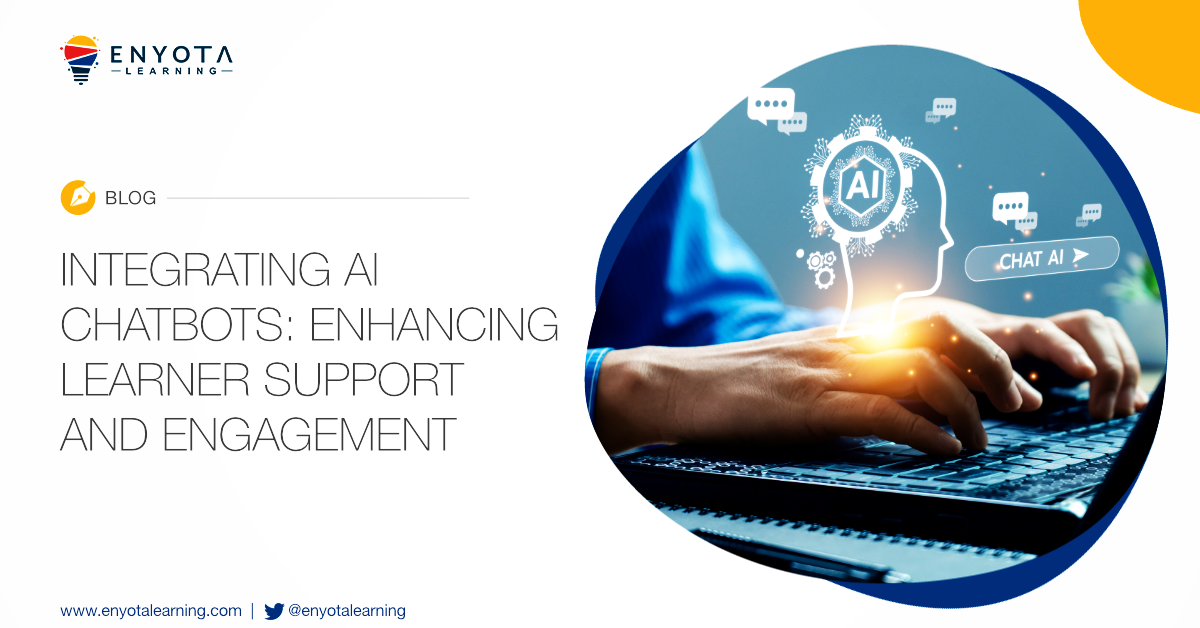NLP or Natural Language Processing, is a branch of artificial intelligence (AI) that focuses on the interaction between computers and human language. In the context of eLearning, NLP refers to the use of AI techniques to analyze, understand, and generate natural language to enhance the learning experience.
NLP in eLearning involves the application of algorithms and models to process, interpret, and respond to human language input in various forms, such as text or speech. It enables eLearning platforms to understand and generate language in a manner that resembles human-like communication, fostering more effective and engaging interactions between learners and digital systems.
Some Key Applications and Benefits of NLP in eLearning
-
Learner Support
NLP-powered virtual assistants or chatbots can understand and respond to learners’ questions, providing real-time support and guidance. Learners can ask queries in natural language, and the system can offer relevant explanations, suggestions, or resources just like a human would. The ability to converse with machines just like humans do with each other is a massive step in the right direction. NLP makes access to correct information even simpler for learners.
-
Personalized Learning
NLP algorithms can analyze learners’ language input, identify their preferences, strengths, and weaknesses, and provide tailored learning recommendations. This personalization helps learners access relevant content, adapt their learning paths, and receive targeted feedback. Since NLP allows learners to interact with the machine like humans would, learners can now ask the machine for assistance in a more direct way, much more than they ever could have before.
-
Language Processing and Understanding
NLP techniques enable eLearning platforms to analyze and understand learners’ written or spoken language. This analysis can include tasks such as sentiment analysis, text classification, entity recognition, summarization, and more, thus enhancing comprehension and engagement. It gives your eLearning platform the ability to first test and then assess, making it more than just a training hosting platform. If your LMS is a custom platform built by you for your own training and development needs, adding an NLP capability makes great sense.
-
Content Curation
NLP can assist in content curation by analyzing and categorizing educational resources. It can extract key information, identify relevant concepts or topics, and recommend appropriate learning materials to learners based on their interests and needs. NLP not only allows the machine to understand humans, but it also allows the machine to understand all written content in existence! This basically means that if your learning library is full of content and you are finding it hard to source the right content to address learner needs, you can simply allow the learner to interact with the machine which can then source the correct information from the content library and deliver it to your learners based on their requirements!
-
Assessment and Feedback
NLP can automate the grading and feedback process by evaluating learners’ written responses or essays. By analyzing the language used, NLP models can provide automated feedback, identify errors, offer suggestions for improvement, and generate personalized assessments. NLPs are exceptionally helpful when it comes to training customer facing staff since building soft skills is one of the most important topics for training such a workforce. The same holds true for sales professionals who can practice their conversational and convincing skills while also practicing effective email writing. The possibilities are endless!
-
Language Learning and Pronunciation
NLP can aid in language training by analyzing learners’ pronunciation, accent, and fluency. It can provide feedback on pronunciation errors, offer pronunciation guides, and facilitate language practice through interactive dialogue systems. Accent Analysis NLP algorithms can analyze learners’ spoken language and identify specific patterns or features that contribute to their accent. By comparing the learner’s speech with standard pronunciation models, NLP systems can detect deviations and provide feedback on accent-related issues.
How Tough is it to Implement an NLP Framework in Your Training Initiatives?
Actually, Chat GPT is the best NLP that can be integrated into your Learning Management System (LMS) to enhance the interactive capabilities and user experience. Integrating Chat GPT into your LMS can provide learners with conversational interfaces, allowing them to ask questions, seek clarification, and receive interactive responses.
Steps to Consider When Integrating Chat GPT into Your LMS
-
API Integration
Check if the Chat GPT model you are using provides an API (Application Programming Interface) that allows communication between your LMS and the model. API integration enables the exchange of data and requests, allowing the LMS to send user queries and receive responses from the Chat GPT model.
-
User Interface Design
Determine how the chat interface will be incorporated into your LMS. You can create a dedicated chat widget or integrate the chat functionality within existing course pages or modules. The chat interface should be intuitive, user-friendly, and seamlessly integrated into the overall LMS user interface.
-
Query Processing
Define the logic and flow of user queries within the LMS. Determine how user queries will be captured and passed to the Chat GPT model for processing. You may need to preprocess or format the queries to ensure compatibility with the model’s input requirements.
-
Response Handling
Once the Chat GPT model generates a response, determine how it will be presented to the learner within the LMS interface. You may need to format or customize the response to fit the design and functionality of your LMS. Consider options for displaying rich content, links, or additional resources based on the generated response.
-
Error Handling and Monitoring
Implement mechanisms to handle errors and exceptions that may occur during the integration process. Monitor the performance and stability of the Chat GPT model within the LMS environment to ensure smooth operation and provide a reliable user experience.
It’s important to note that integrating Chat GPT into your LMS requires technical expertise in software development, API integration, and system architecture. Consider involving experienced developers or working with a vendor that specializes in LMS integration to ensure a seamless and successful integration process. Alternatively, many LMS providers are already providing their platforms with integration to Chat GPT. It’s one of the best ways to get started!




